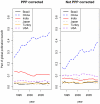Spatial and temporal trends of global pollination benefit
- PMID: 22563427
- PMCID: PMC3338563
- DOI: 10.1371/journal.pone.0035954
Spatial and temporal trends of global pollination benefit
Abstract
Pollination is a well-studied and at the same time a threatened ecosystem service. A significant part of global crop production depends on or profits from pollination by animals. Using detailed information on global crop yields of 60 pollination dependent or profiting crops, we provide a map of global pollination benefits on a 5' by 5' latitude-longitude grid. The current spatial pattern of pollination benefits is only partly correlated with climate variables and the distribution of cropland. The resulting map of pollination benefits identifies hot spots of pollination benefits at sufficient detail to guide political decisions on where to protect pollination services by investing in structural diversity of land use. Additionally, we investigated the vulnerability of the national economies with respect to potential decline of pollination services as the portion of the (agricultural) economy depending on pollination benefits. While the general dependency of the agricultural economy on pollination seems to be stable from 1993 until 2009, we see increases in producer prices for pollination dependent crops, which we interpret as an early warning signal for a conflict between pollination service and other land uses at the global scale. Our spatially explicit analysis of global pollination benefit points to hot spots for the generation of pollination benefits and can serve as a base for further planning of land use, protection sites and agricultural policies for maintaining pollination services.
Conflict of interest statement
Figures















References
-
- MEA (Millenium Ecosystem Assessment) 2005. Ecosystems and human well-being: current state and trends (Island Press)
-
- TEEB. 2010. The Economics of Ecosystems & Biodiversity - Mainstreaming the economics of nature - a synthesis of the approach, conclusions and recommendations of TEEB Available at: http://www.teebweb.org/
-
- Fisher B, Turner K, Zylstra M, Brouwer R, de Groot R, et al. Ecosystem services and economic theory: integration for policy-relevant research. Ecological Applications. 2008;18:2050–67. - PubMed
-
- Seppelt R, Eppink FV, Lautenbach S, Schmidt S, Dormann CF. A quantitative review of ecosystem service studies: Approaches, shortcomings and the road ahead. Journal of Applied Ecology. 2011;48:630–636.
-
- de Groot RS, Alkemade R, Braat L, Hein L, Willemen L. Challenges in integrating the concept of ecosystem services and values in landscape planning, management and decision making. Ecological Complexity. 2010;7:260–272.
Publication types
MeSH terms
Substances
LinkOut - more resources
Full Text Sources
Molecular Biology Databases

